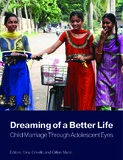| dc.identifier.citation | Mowri , S., Sultana, R., Biswas, S., Azmi, R., Ahsan, S., & F. Rashid, S. (2020). Binary Framing of Consent and Coercion of Child Marriage: A Critique. In G. Crivello & G. Mann (Eds.), Dreaming of a Better Life: Child Marriage Through Adolescent Eyes (pp. 21–32). Oxford, UK: Young Lives. Retrieved from https://www.younglives.org.uk/sites/www.younglives.org.uk/files/YL-DreamingOfBetterLife-LowRes_0.pdf | en_US |
| dc.description.abstract | The rhetoric around child marriage continues to be framed in binary terms, with the difference
between ‘arranged’ and ‘love’ marriages hinging on the concept of consent.1
The context in
which consent is constructed, however, remains less explored. ‘Lack of consent’ is a very
hard concept to define. Most studies tend to focus on the support for, and history of, victims
of non-consent (Abu Amara, Guiné, and Hamel 2013) rather than seeking to define it, since
the research concerns women who report being the victims of forced marriage. Overall, the
concept of consent has been left relatively undefined and understudied. It is important to
rectify this and collectively agree to what constitutes affirmative consent, so we can truly know
how far theory and practice coincide, and whether genuine consent is truly possible within the
institutions of poverty and marriage.
In this chapter, we examine the socio-cultural construction of consent, especially with regard
to early or child marriage,2
and the intersecting structural inequalities that constrain particular
groups of young women in the urban slums of Bangladesh. As Nicole-Claude Mathieu (1985)
rightly pointed out, ‘giving in is not the same as consenting’; similarly, our analysis of 65
qualitative interviews with adolescent girls and young women also suggests that consenting
to marriage is almost never free of degrees of socio-cultural obligations, control of sexuality,
persuasion, pressure, threat and force from different actors.
We explore a range of situations where young women yield to social pressures and consent
to marriage. However, ‘pressure’ in this context is not necessarily limited to violence or
intimidation, but rather marriage as a norm that cannot be challenged. The girls attribute their
early marriages and lack of alternatives to circumstances ‘beyond their control’. The affection
and trust that they felt for their parents prevented them from labelling their obligations as
coercion. On the other hand, there are cases of girls who claimed to have been ‘forced to
consent’ to marry their boyfriends who would have otherwise ‘committed suicide’. These
narratives warrant contextualisation to determine the consent–coercion continuum. | en_US |

